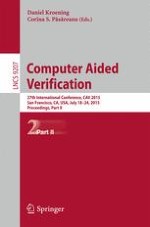The two-volume set LNCS 9206 and LNCS 9207 constitutes the refereed proceedings of the 27th International Conference on Computer Aided Verification, CAV 2015, held in San Francisco, CA, USA, in July 2015.
The total of 58 full and 11 short papers presented in the proceedings was carefully reviewed and selected from 252 submissions. The papers were organized in topical sections named: model checking and refinements; quantitative reasoning; software analysis; lightning talks; interpolation, IC3/PDR, and Invariants; SMT techniques and applications; HW verification; synthesis; termination; and concurrency.
